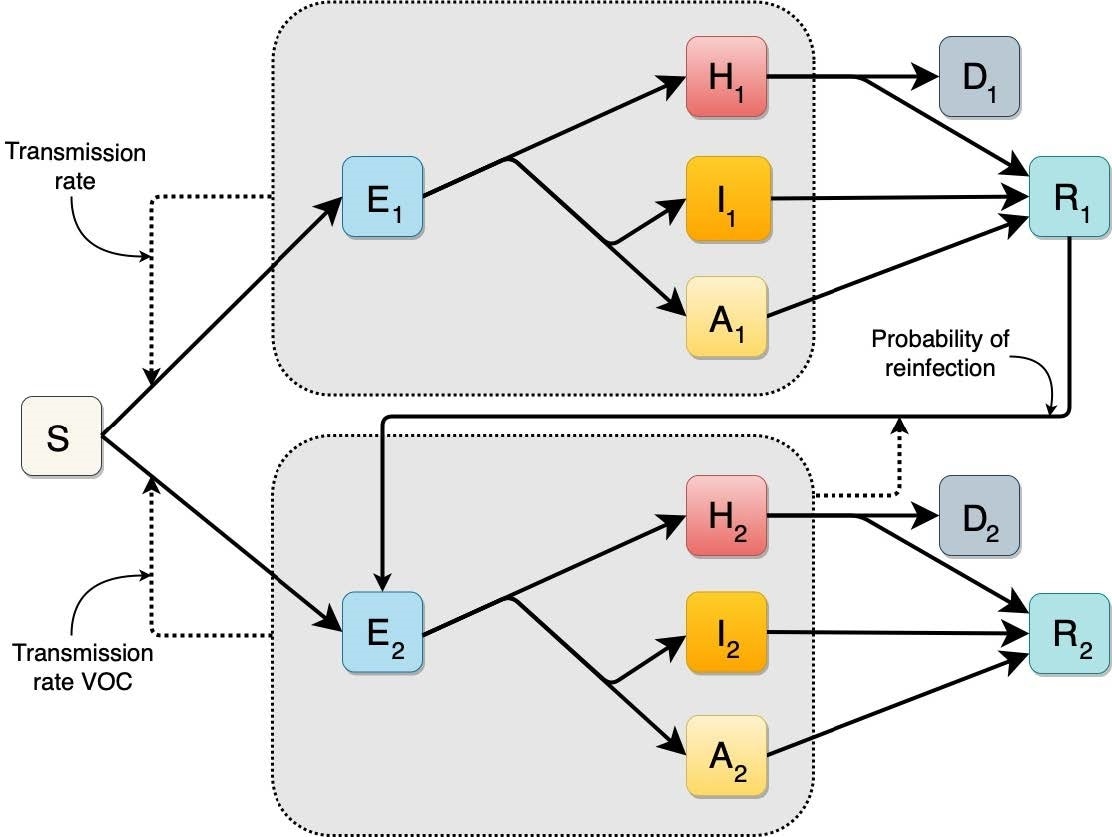In early January 2021, a new variant of severe acute respiratory syndrome coronavirus 2 (SARS-CoV-2) was identified from travelers returning from Brazil. This variant, referred to as “P.1”, likely emerged in early-to-late November 2020, and subsequently spread throughout Manaus, the state capital of Amazonas, Brazil, over the following December.
Researchers from Brazil modeled the rates of infection from ‘susceptible’ individuals to ‘exposed’ individuals for the P.1 variant, and found that the rate of transmission of the new variant was x2.5 times higher than the ancestral strain first identified from Wuhan. They also found that there was a low risk of reinfection for individuals who had been infected with the original wave 1 variant (6.4%).
A pre-print version of the research paper is available to read in full on the medRxiv* server.

Diagram extended Susceptible, Exposed, Infected, and Recovered (SEIR) deterministic compartmental (SEAIHRD) model. S: Susceptible, E: Exposed (pre-symptomatic), H: Hospitalized (severe infected individuals), I: Infected (symptomatic individuals, not hospitalized), A: Asymptomatic. D: Deceased, R: Recovered. Compartments are subdivided into 3 age classes, not represented here for simplicity. Compartments with no subindex are related to the wild-type variant, compartments with subindex 2 are related to the VOC P.1. Continuous lines represent flux between each compartment. Dashed lines represent infection pathways. Three parameters fitted by the model are indicated by the small arrows.

 This news article was a review of a preliminary scientific report that had not undergone peer-review at the time of publication. Since its initial publication, the scientific report has now been peer reviewed and accepted for publication in a Scientific Journal. Links to the preliminary and peer-reviewed reports are available in the Sources section at the bottom of this article. View Sources
This news article was a review of a preliminary scientific report that had not undergone peer-review at the time of publication. Since its initial publication, the scientific report has now been peer reviewed and accepted for publication in a Scientific Journal. Links to the preliminary and peer-reviewed reports are available in the Sources section at the bottom of this article. View Sources
Renato Coutinho and colleagues acquired data on Coronavirus disease 2019 (COVID-19) hospitalization cases in Manaus using the Brazilian epidemiological syndromic surveillance system – SIVEP Gripe. Data for hospitalized patients between November 1st 2020 to January 31st 2021 was used to determine the rates of transmissibility and reinfection of the P.1 variant. Within this three-month period, the frequency of the variant had risen in Manaus from 0% of patients to 73%. The team also used nowcasted data to account for the period of time from 31st January up to 15th February, when the data was collected.
The researchers used a deterministic compartmental model to observe rates of infection across three categories: ‘hospitalized’, ‘infected’ (symptomatic but non-hospitalized), and ‘asymptomatic.’ Each category was subsequently divided into three further compartments according to ages: ‘young’ (under 20 years old), ‘adult’ (between 20 and 60 years old), and ‘elderly’ (over 60 years old). They compared the P.1 variant with the original variant to evaluate rates of transmission and reinfection.
Their results confer with findings from other studies that have estimated the rate of P.1 transmissibility to be higher than that of the original strain (x1.4-2.2).
The P.1 variant has been detected in at least 25 countries at present. Coutinho and colleagues note that transmissibility of P.1 might be lower than they found if waning immunity is an important aspect of COVID-19 and recognize that the study is limited somewhat by convenience-sampling and small sample size. However, they caution that serious measures of mitigation and further immunological & pathogenicity studies need to be undertaken to fully understand the extent of P.1.

 This news article was a review of a preliminary scientific report that had not undergone peer-review at the time of publication. Since its initial publication, the scientific report has now been peer reviewed and accepted for publication in a Scientific Journal. Links to the preliminary and peer-reviewed reports are available in the Sources section at the bottom of this article. View Sources
This news article was a review of a preliminary scientific report that had not undergone peer-review at the time of publication. Since its initial publication, the scientific report has now been peer reviewed and accepted for publication in a Scientific Journal. Links to the preliminary and peer-reviewed reports are available in the Sources section at the bottom of this article. View Sources
Journal references:
- Preliminary scientific report.
Coutinho R, et al. Model-based estimation of transmissibility and reinfection of SARS-CoV-2 P.1 variant. medRxiv, 2021. doi: https://doi.org/10.1101/2021.03.03.21252706, https://www.medrxiv.org/content/10.1101/2021.03.03.21252706v2
- Peer reviewed and published scientific report.
Coutinho, Renato Mendes, Flavia Maria Darcie Marquitti, Leonardo Souto Ferreira, Marcelo Eduardo Borges, Rafael Lopes Paixão da Silva, Otavio Canton, Tatiana P. Portella, et al. 2021. “Model-Based Estimation of Transmissibility and Reinfection of SARS-CoV-2 P.1 Variant.” Communications Medicine 1 (1). https://doi.org/10.1038/s43856-021-00048-6. https://www.nature.com/articles/s43856-021-00048-6.
Article Revisions
- Apr 6 2023 - The preprint preliminary research paper that this article was based upon was accepted for publication in a peer-reviewed Scientific Journal. This article was edited accordingly to include a link to the final peer-reviewed paper, now shown in the sources section.